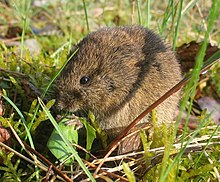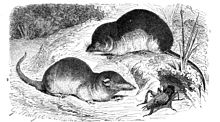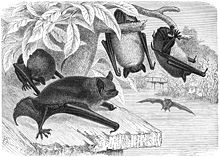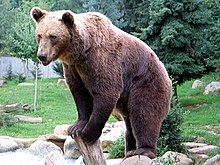List of mammals of Switzerland
This list shows the IUCN Red List status of the mammal species occurring in Switzerland. Nine of them are near threatened, and most are least concern. The following tags are used to highlight each species' status as assessed on the respective Red List published by the International Union for Conservation of Nature:
| EX | Extinct | No reasonable doubt that the last individual has died. |
| EW | Extinct in the wild | Known only to survive in captivity or as a naturalized populations well outside its previous range. |
| CR | Critically endangered | The species is in imminent risk of extinction in the wild. |
| EN | Endangered | The species is facing an extremely high risk of extinction in the wild. |
| VU | Vulnerable | The species is facing a high risk of extinction in the wild. |
| NT | Near threatened | The species does not meet any of the criteria that would categorise it as risking extinction but it is likely to do so in the future. |
| LC | Least concern | There are no current identifiable risks to the species. |
| DD | Data deficient | There is inadequate information to make an assessment of the risks to this species. |
Subclass: Theria
Infraclass: Eutheria
Order: Rodentia (rodents)


Rodents make up the largest order of mammals, with over 40% of mammalian species. They have two incisors in the upper and lower jaw which grow continually and must be kept short by gnawing.
- Suborder: Castorimorpha
- Family: Castoridae
- Subfamily: Castorinae
- Tribe: Castorini
- Genus: Castor
- Eurasian beaver, C. fiber LC[1]
- Genus: Castor
- Tribe: Castorini
- Subfamily: Castorinae
- Family: Castoridae
- Suborder: Sciurognathi
- Family: Sciuridae (squirrels)
- Subfamily: Sciurinae
- Tribe: Sciurini
- Genus: Sciurus
- Red squirrel, S. vulgaris LC[2]
- Genus: Sciurus
- Tribe: Sciurini
- Subfamily: Xerinae
- Tribe: Marmotini
- Genus: Marmota
- Alpine marmot, M. marmota LC
- Genus: Marmota
- Tribe: Marmotini
- Subfamily: Sciurinae
- Family: Gliridae (dormice)
- Subfamily: Leithiinae
- Genus: Dryomys
- Forest dormouse, D. nitedula LC
- Genus: Eliomys
- Garden dormouse, E. quercinus NT[3]
- Genus: Muscardinus
- Hazel dormouse, M. avellanarius LC
- Genus: Dryomys
- Subfamily: Glirinae
- Genus: Glis
- Edible dormouse, G. glis LC
- Genus: Glis
- Subfamily: Leithiinae
- Family: Cricetidae
- Subfamily: Arvicolinae
- Genus: Arvicola
- European water vole, A. amphibius LC[4]
- Genus: Chionomys
- European snow vole, C. nivalis LC
- Genus: Clethrionomys
- Bank vole, C. glareolus LC
- Genus: Microtus
- Field vole, M. agrestis LC
- Common vole, M. arvalis LC
- Alpine pine vole, M. multiplex LC
- European pine vole, M. subterraneus LC
- Genus: Arvicola
- Subfamily: Arvicolinae
- Family: Muridae (mice, rats, voles, gerbils, hamsters)
- Subfamily: Murinae
- Genus: Mus
- House mouse, M. musculus LC
- Genus: Apodemus
- Alpine field mouse, A. alpicola LC
- Yellow-necked mouse, A. flavicollis LC
- Wood mouse, A. sylvaticus LC
- Genus: Micromys
- Eurasian harvest mouse, M. minutus LC
- Genus: Mus
- Subfamily: Murinae
- Family: Sciuridae (squirrels)
Order: Lagomorpha (lagomorphs)

The lagomorphs comprise two families, Leporidae (hares and rabbits), and Ochotonidae (pikas). Though they can resemble rodents, and were classified as a superfamily in that order until the early 20th century, they have since been considered a separate order. They differ from rodents in a number of physical characteristics, such as having four incisors in the upper jaw rather than two.
- Family: Leporidae (rabbits, hares)
- Genus: Oryctolagus
- European rabbit, O. cuniculus EN[5] introduced in Iberian Peninsula
- Genus: Lepus
- European hare, L. europaeus LC[6]
- Mountain hare, L. timidus LC
- Genus: Oryctolagus
Order: Eulipotyphla (shrews, hedgehogs and moles)





Eulipotyphlans are insectivorous mammals. Shrews and solenodons resemble mice, hedgehogs carry spines, gymnures look more like large rats, while moles are stout-bodied burrowers.
- Family: Erinaceidae (hedgehogs)
- Subfamily: Erinaceinae
- Genus: Erinaceus
- West European hedgehog, E. europaeus LC[7]
- Genus: Erinaceus
- Subfamily: Erinaceinae
- Family: Soricidae (shrews)
- Subfamily: Crocidurinae
- Genus: Crocidura
- Bicolored shrew, Crocidura leucodon LC
- Greater white-toothed shrew, Crocidura russula LC
- Lesser white-toothed shrew, Crocidura suaveolens LC
- Genus: Crocidura
- Subfamily: Soricinae
- Tribe: Nectogalini
- Genus: Neomys
- Mediterranean water shrew, Neomys anomalus LC
- Eurasian water shrew, Neomys fodiens LC
- Genus: Neomys
- Tribe: Soricini
- Genus: Sorex
- Alpine shrew, Sorex alpinus NT
- Common shrew, Sorex araneus LC
- Crowned shrew, Sorex coronatus LC
- Eurasian pygmy shrew, Sorex minutus LC
- Genus: Sorex
- Tribe: Nectogalini
- Subfamily: Crocidurinae
- Family: Talpidae (moles)
- Subfamily: Talpinae
- Tribe: Talpini
- Genus: Talpa
- Mediterranean mole, Talpa caeca LC
- European mole, Talpa europaea LC
- Genus: Talpa
- Tribe: Talpini
- Subfamily: Talpinae
Order: Chiroptera (bats)



The bats' most distinguishing feature is that their forelimbs are developed as wings, making them the only mammals capable of flight. Bat species account for about 20% of all mammals.
- Family: Vespertilionidae
- Subfamily: Myotinae
- Genus: Myotis
- Bechstein's bat, M. bechsteini NT[8]
- Greater mouse-eared bat, M. myotis LC[9]
- Lesser mouse-eared bat, M. blythii LC[10]
- Brandt's bat, M. brandti LC
- Daubenton's bat, M. daubentonii LC
- Geoffroy's bat, M. emarginatus LC
- Natterer's bat, M. nattereri LC
- Cryptic myotis, M. crypticus not assessed
- Genus: Myotis
- Subfamily: Vespertilioninae
- Genus: Barbastella
- Barbastelle, B. barbastellus NT
- Genus: Eptesicus
- Northern bat, E. nilssoni LC
- Genus: Nyctalus
- Greater noctule bat, N. lasiopterus NT[11]
- Lesser noctule, N. leisleri LC[12]
- Common noctule, N. noctula LC[13]
- Genus: Pipistrellus
- Nathusius' pipistrelle, P. nathusii LC[14]
- Genus: Plecotus
- Brown long-eared bat, P. auritus LC
- Grey long-eared bat, P. austriacus LC
- Genus: Barbastella
- Subfamily: Miniopterinae
- Genus: Miniopterus
- Common bent-wing bat, M. schreibersii NT
- Genus: Miniopterus
- Subfamily: Myotinae
- Family: Molossidae
- Genus: Tadarida
- European free-tailed bat, T. teniotis LC
- Genus: Tadarida
- Family: Rhinolophidae
- Subfamily: Rhinolophinae
- Genus: Rhinolophus
- Greater horseshoe bat, R. ferrumequinum NT
- Lesser horseshoe bat, R. hipposideros NT
- Genus: Rhinolophus
- Subfamily: Rhinolophinae
Order: Carnivora (carnivorans)



There are over 260 species of carnivorans, the majority of which feed primarily on meat. They have a characteristic skull shape and dentition.
- Suborder: Feliformia
- Family: Felidae (cats)
- Subfamily: Felinae
- Genus: Felis
- European wildcat, F. silvestris LC
- Genus: Lynx
- Eurasian lynx, L. lynx LC[15]
- Genus: Felis
- Subfamily: Felinae
- Family: Felidae (cats)
- Suborder: Caniformia
- Family: Canidae
- Genus: Canis
- Gray wolf, C. lupus LC[16]
- Eurasian wolf, C. l. lupus
- Italian wolf, C. l. italicus
- Gray wolf, C. lupus LC[16]
- Genus: Vulpes
- Genus: Canis
- Family: Ursidae (bears)
- Genus: Ursus
- Brown bear, U. arctos LC[18]
- Eurasian brown bear, U. a. arctos
- Brown bear, U. arctos LC[18]
- Genus: Ursus
- Family: Mustelidae (mustelids)
- Genus: Mustela
- Stoat, M. erminea LC[19]
- Least weasel, M. nivalis LC[20]
- European polecat, M. putorius LC[21]
- Genus: Martes
- Beech marten, M. foina LC[22]
- European pine marten, M. martes LC[23]
- Genus: Meles
- Eurasian badger, M. meles LC[24]
- Genus: Lutra
- European otter, L. lutra NT[25]
- Genus: Mustela
- Family: Canidae
Order: Artiodactyla (even-toed ungulates)

The even-toed ungulates are ungulates whose weight is borne about equally by the third and fourth toes, rather than mostly or entirely by the third as in perissodactyls. There are about 220 artiodactyl species, including many that are of great economic importance to humans.
- Family: Suidae (pigs)
- Family: Cervidae (deer)
- Family: Bovidae (cattle, antelope, sheep, goats)
- Subfamily: Caprinae
- Genus: Capra
- Alpine ibex, Capra ibex LC
- Genus: Rupicapra
- Chamois, Rupicapra rupicapra LC
- Genus: Capra
- Subfamily: Caprinae
History

Several mammal species became extinct in Switzerland in the 19th and 20th centuries, mostly due to hunting for fur and meat:
- The Eurasian beaver was extirpated in the country in the early 19th century. Between 1956 and 1977, 141 individuals were reintroduced to 30 sites in the Rhone and Rhine catchment areas.[26]
- The brown bear was extinct in the country since the early 20th century, with the last known individual killed in 1904. It has been legally protected since 1962. Individual are dispersing to the Swiss Alps coming from Austria and Trentino in Italy.[27]
- Alpine ibex, Capra ibex, extinct around 1850 and reintroduced in 1911.[28]
- Eurasian lynx, Lynx lynx, last observation around 1900 and reintroduced in the 1970s.[28]
- Grey wolf, Canis lupus, extinct in the twentieth century. Naturally coming back from Italy since the 1990s.[28]
- Eurasian otter, Lutra lutra, last observation in 1989.[29] Naturally coming back in the 2010s.[30]
Some species of mammals were almost extinct, such as the red deer around 1850, which then came back from Austria.[28]
Extinction other than mammals
- Bearded vulture, Gypaetus barbatus, hunted until extinction in the nineteenth century, reintroduced starting in 1986.[28]
- White stork, Ciconia ciconia, extinct in the 1950s and reintroduced.[31]
- European pond turtle, Emys orbicularis, extinct at the beginning of the twentieth century and reintroduced begininning in 2010.[32]
Some species, such as the golden eagle, Aquila chrysaetos, were almost extinct, until they were protected.[28]
See also
- List of chordate orders
- Lists of mammals by region
- List of prehistoric mammals
- Mammal classification
- List of mammals described in the 2000s
References
- ^ Batbold, J.; Batsaikhan, N.; Shar, S.; Hutterer, R.; Kryštufek, B.; Yigit, N.; Mitsain, G.; Palomo, L. (2016). "Castor fiber". IUCN Red List of Threatened Species. 2016: e.T4007A115067136.
{{cite journal}}: Unknown parameter|last-author-amp=ignored (|name-list-style=suggested) (help) - ^ Amori, G.; Hutterer, R.; Kryštufek, B.; Yigit, N.; Mitsain, G.; Muñoz, L. J. P. (2010). "Sciurus vulgaris". IUCN Red List of Threatened Species. 2010: e.T20025A9136220.
{{cite journal}}: Unknown parameter|last-author-amp=ignored (|name-list-style=suggested) (help) - ^ Bertolino, S.; Amori, G.; Henttonen, H.; Zagorodnyuk, I.; Zima, J.; Juškaitis, R.; Meinig, H.; Kryštufek, B. (2008). "Eliomys quercinus". IUCN Red List of Threatened Species. 2008: e.T7618A12835766.
{{cite journal}}: Unknown parameter|last-author-amp=ignored (|name-list-style=suggested) (help) - ^ Batsaikhan, N.; Henttonen, H.; Meinig, H.; Shenbrot, G., Bukhnikashvili, A., Hutterer, R., Kryštufek, B., Yigit, N., Mitsain, G. & Palomo, L. (2016). "Arvicola amphibius". IUCN Red List of Threatened Species. 2016: e.T2149A115060819.
{{cite journal}}: CS1 maint: multiple names: authors list (link) - ^ Villafuerte, R.; Delibes-Mateos, M. (2019). "Oryctolagus cuniculus". IUCN Red List of Threatened Species. 2019: e.T41291A45189779.
{{cite journal}}: Unknown parameter|last-author-amp=ignored (|name-list-style=suggested) (help) - ^ Hacklande, K.; Schai-Braun, S. (2019). "Lepus europaeus". IUCN Red List of Threatened Species. 2019: e.T41280A45187424.
{{cite journal}}: Unknown parameter|last-author-amp=ignored (|name-list-style=suggested) (help) - ^ Amori, G. (2016). "Erinaceus europaeus". IUCN Red List of Threatened Species. 2016: e.T29650A2791303.
- ^ Paunović, M. (2019). "Myotis bechsteinii'". IUCN Red List of Threatened Species. 2019: e.T14123A22053752.
- ^ Coroiu, I.; Juste, J. & Paunović, M. (2016). "Myotis myotis". IUCN Red List of Threatened Species. 2016: e.T14133A22051759.
{{cite journal}}: CS1 maint: multiple names: authors list (link) - ^ Juste, J. & Paunović, M. (2016). "Myotis blythii". IUCN Red List of Threatened Species. 2016: e.T14124A22053297.
{{cite journal}}: CS1 maint: multiple names: authors list (link) - ^ Hutson, A. M.; Alcaldé, J. T.; Juste, J.; Karataş, A.; Palmeirim, J. & Paunović, M. (2010). "Nyctalus lasiopterus". IUCN Red List of Threatened Species. 2010: e.T14918A4471682.
{{cite journal}}: CS1 maint: multiple names: authors list (link) - ^ Juste, J. & Paunović, M. (2016). "Nyctalus leisleri". IUCN Red List of Threatened Species. 2016: e.T14919A22016159.
{{cite journal}}: CS1 maint: multiple names: authors list (link) - ^ Csorba, G. & Hutson, A.M. (2016). "Nyctalus noctula". IUCN Red List of Threatened Species. 2016: e.T14920A22015682.
{{cite journal}}: CS1 maint: multiple names: authors list (link) - ^ Hutson, A. M.; Spitzenberger, F.; Juste, J.; Aulagnier, S.; Palmeirim, J.; Karatas, A. & Paunovic, M. (2010). "Pipistrellus nathusii". IUCN Red List of Threatened Species. 2010: e.T17316A6966886.
{{cite journal}}: CS1 maint: multiple names: authors list (link) - ^ Breitenmoser, U.; Breitenmoser-Würsten, C.; Lanz, T.; von Arx, M.; Antonevich, A.; Bao, W.; Avgan, B. (2015). "Lynx lynx". IUCN Red List of Threatened Species. 2015: e.T12519A121707666.
{{cite journal}}: Unknown parameter|last-author-amp=ignored (|name-list-style=suggested) (help) - ^ Boitani, L.; Phillips, M. & Jhala, Y. (2018). "Canis lupus". IUCN Red List of Threatened Species. 2018: e.T3746A119623865.
{{cite journal}}: CS1 maint: multiple names: authors list (link) - ^ Hoffmann, M.; Sillero-Zubiri, C. (2016). "Vulpes vulpes". IUCN Red List of Threatened Species. 2016: e.T23062A46190249.
- ^ McLellan, B. N.; Proctor, M. F.; Huber, D.; Michel, S. (2017). "Ursus arctos". IUCN Red List of Threatened Species. 2017: e.T41688A121229971.
{{cite journal}}: Unknown parameter|last-author-amp=ignored (|name-list-style=suggested) (help) - ^ Reid, F.; Helgen, K.; Kranz, A. (2016). "Mustela erminea". IUCN Red List of Threatened Species. 2016: e.T29674A45203335.
{{cite journal}}: Unknown parameter|last-author-amp=ignored (|name-list-style=suggested) (help) - ^ McDonald, R. A.; Abramov, A. V.; Stubbe, M.; Herrero, J.; Maran, T.; Tikhonov, A.; Cavallini, P.; Kranz, A.; Giannatos, G.; Kryštufek, B.; Reid, F. (2019). "Mustela nivalis". IUCN Red List of Threatened Species. 2019: e.T70207409A147993366.
{{cite journal}}: Unknown parameter|last-author-amp=ignored (|name-list-style=suggested) (help) - ^ Skumatov, D.; Abramov, A.V.; Herrero, J.; Kitchener, A.; Maran, T.; Kranz, A.; Sándor, A.; Stubbe, M.; Saveljev, A.; Savour-Soubelet, A.; Guinot-Ghestem, M.; Zuberogoitia, I.; Birks, J.D.S.; Weber, A.; Melisch, R. & Ruette, S. (2016). "Mustela putorius". IUCN Red List of Threatened Species. 2016: e.T41658A45214384.
{{cite journal}}: CS1 maint: multiple names: authors list (link) - ^ Abramov, A.V.; Kranz, A.; Herrero, J.; Krantz, A.; Choudhury, A.; Maran, T. (2016). "Martes foina". IUCN Red List of Threatened Species. 2016: e.T29672A45202514.
{{cite journal}}: Unknown parameter|last-author-amp=ignored (|name-list-style=suggested) (help) - ^ Herrero, J.; Kranz, A.; Skumatov, D.; Abramov, A.V.; Maran, T.; Monakhov, V.G. (2016). "Martes martes". IUCN Red List of Threatened Species. 2016: e.T12848A45199169.
{{cite journal}}: Unknown parameter|last-author-amp=ignored (|name-list-style=suggested) (help) - ^ Kranz, A.; Abramov, A. V.; Herrero, J.; Maran, T. (2016). "Meles meles". IUCN Red List of Threatened Species. 2016: e.T29673A45203002.
{{cite journal}}: Unknown parameter|last-author-amp=ignored (|name-list-style=suggested) (help) - ^ Roos, A.; Loy, A.; de Silva, P.; Hajkova, P.; Zemanová, B. (2015). "Lutra lutra". IUCN Red List of Threatened Species. 2015: e.T12419A21935287.
- ^ Minnig, S.; Angst, C.; Jacob, G. (2016). "Genetic monitoring of Eurasian beaver (Castor fiber) in Switzerland and implications for the management of the species". Russian Journal of Theriology. 15 (1): 20–27. doi:10.15298/rusjtheriol.15.1.04.
- ^ Zajec, P.; Zimmermann, F.; Roth, H.U.; Breitenmoser, U. (2005). The return of brown bear to Switzerland – Suitable habitat distribution, corridors and potential conflicts (Report). Muri: KORA.
- ^ a b c d e f (in French) Heinz Staffelbach, Manuel des Alpes suisses. Flore, faune, roches et météorologie, Rossolis, 2009 (ISBN 978-2-940365-30-2). Also available in German: Heinz Staffelbach, Handbuch Schweizer Alpen. Pflanzen, Tiere, Gesteine und Wetter, Haupt Verlag, 2008 (ISBN 978-3-258-07638-6).
- ^ Lucini, D. (2005). "Le retour des animaux disparus". Swissinfo (in French).
- ^ (in French) Loutre : coucou, la revoilà !, 27 November 2014, Federal Office for the Environment, Federal Department of Environment, Transport, Energy and Communications (page visited on 2 August 2016).
- ^ (in French) Olivier Biber et Martin Moritzi, "Inversion de tendance chez la cigogne blanche", Wildtier Schweiz (page visited on 2 August 2016).
- ^ Julien Perrot, "Dans la peau d'une tortue", La Salamandre, number 235, August 2016, pages 20-45 (especially pages 32-33).
External links
- "Animal Diversity Web". University of Michigan Museum of Zoology. 1995–2006. Retrieved 6 August 2012.
